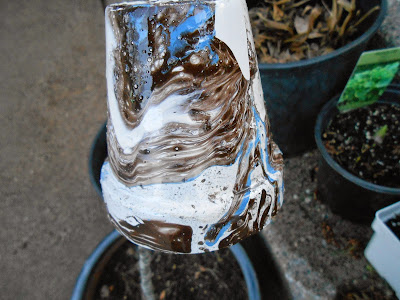I have been trying to find an interesting way to update some of my flower pots without having to spend much money. So, as I was searching on the internet I came across marbling for fingernails on Youtube and I thought "THAT'S IT!" I have got to find a way to do that to my pots. Now there is a marbling technique for pots that someone had instructions for, but they used nail polish. I was
looking for something cheaper-maybe something I had enough of on hand that I did not have to buy. Nail polish isn't cheap you know. So I searched my garage and came up with some cans of spray paint that I had purchased for other projects. That would be perfect (I did have to go out and buy a can of white-the can I had would not spray).
Here is a list of what you will need:
1. A flower pot of your choice.
2. Some gloves (unless you want marbled hands and nails:-))
3. Plastic tub-size depends on the size of the pot but it should be shallow but wide enough to roll your pot around in it.
4. Water
5. White spray paint of your choice (serves as the base for your colors)
6. Other colors of spray paint-I would use at least 3 different ones.
7. A strong stick to hold the pot. 2 if you want to use one to roll the pot in the water.
 |
| These are the colors that I used. |
Here are the steps to marble your pots:
1. Choose your flower pot.
2. Paint the pot white and let it dry.
 |
| I choose a little one because I was afraid:-)) |
3. Fill your container half way with water.
 |
| For the small pot I just used an old Easter tub I found laying around. |
|
4. Start by spraying the spray paint on top of the water-you should do just short squirts of each color. Just a note: you have a couple of minutes to work with before the paint starts to dry on the surface so try to do it relatively quickly.
 |
| This is what your first squirt should look like. | | |
|
5. Grab your next color and squirt it inside of the first color.
 |
| Second squirt in the first squirt. |
6. Repeat step 5 with the next color.
7. Repeat the colors until the surface of the water is covered with spray paint-just use your imagination. I started a new "ring" in the water next to the first one.
8. Place your pot on the stick, then lay the pot in the water (about an inch or so down in the water) and try to roll it through the spray paint, I tried using another stick to roll it but it didn't work for me so I used my finger.. Roll it through quickly-make it a continuous roll if you can (otherwise the pattern will not be continuous-but it still looks ok).
9. To dry I found it easiest to leave the pot on the stick and then take it outside and stick it in a pot of dirt to dry, but you can do whatever is easiest for you. Here it is drying:
10. I even did the saucer which was much easier-I just "dunked" it in and it looks pretty good.
 |
| Saucer after being "dipped". |
11. To clean up just wait a few more minutes for the paint to dry and skim it off the water's surface then dump the water. Cleanup isn't too bad is it?
12. I also did a larger pot in a bigger tub
 |
| Picture of the tub I used for the second attempt. |
 |
| Here is the second pot I did. |
Here are the completed pots-I plan on sealing them (with spray paint sealer) before I plant them just to make sure the paint lasts.
 |
| Marbled clay pots |
I am thinking that this could be done with oil based latex paints. In fact, it might give more control to the design aspect and you could make designs since spray paint does it's own thing. I will have to check that out! I hope you like this idea!
Happy Planting!!!!
Rhonda
































